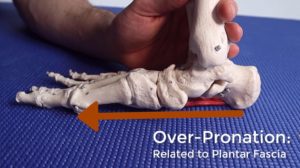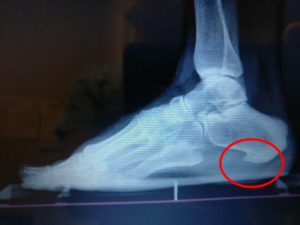Plantar Fasciitis Myths: How NOT to Cure Your Plantar Fasciitis!
If you BELIEVE these plantar fascia myths, you will NOT Cure your plantar fasciitis. Find out the 100% best plantar fasciitis treatment methods!
Table of Contents
Myth #1) I just need to work out and stretch it more:
Truth: It is impossible to strengthen and make a damaged ligament and muscle more flexible!
- This is like over training in as a weightlifter. If you do the same muscle group as hard as you can every single day, you will overload the muscle and injure it.
- Your plantar fascia or Achilles tendon is already overloaded!
- It will very quickly will become sorer and more injured and must give up altogether.
- At its core this is the problem of plantar fasciitis.
- It is an overworked and injured ligament, with microscopic tears throughout it. By simply working it harder, it has absolutely no chance of getting better.

Myth #2) No pain, No gain:
Truth: Pain = Injury!
- This is like the working out and stretching of the plantar fasciitis. Most people can get better without pushing it. You do not have to suffer more and become more injured in order to get better.
- Telling yourself that you are fine and going about your workday, is a recipe for disaster.
- The truth is that if you’re plantar fasciitis is getting worse, you will have to sometimes take a break from fun activities, running and possibly even modify your work conditions or school conditions in order to have a chance to get better.
- Even if you have been suffering with this pain for 10 or more years, now is the time to fix it!

Achilles tendon bone spur is at the back of the heel were the Achilles tendon inserts.
Myth#3) An all-natural home remedy always works for my friend!
Truth: Some can be dangerous and only work because the person doing it had a mild case of inflammation or acute tendinitis.
- This is one of the more common and dangerous statements we hear.
- The person giving advice is usually well meaning but does not understand the anatomy and disease well.
- I promise you that there is not a secret society of doctors hiding secret supplements or all-natural cures to make money off you!
- There are YouTube videos and published books selling pills and easy to apply creams that will fix it.
- Do not fall for the scams, otherwise heel pain would already be eradicated!
Myth #4) It will go away if I take enough pills:
Truth: Pain medication and anti-inflammatories can be dangerous and are not a permanent solution.
- This is like the home remedies myth, if it is a basic flareup, the anti-inflammatories may help you weather the storm.
- Long term pill abuse including anti-inflammatories can be deadly and harmful to your organs.
- For most people, the inflammation is a symptom of a much deeper cause.
- Do not mask the deeper and underlying causes such as being overweight, having poor muscle mass, working for too many hours, or having a previous injury you will not get better.
Myth #5) I will just change the way I walk:
Truth: Changing how you walk will eventually overload and damage other joints.
- Walking on your tippy toes or with your legs turned out will only make the problem worse.
- This places more pressure on the inside and front of your knees. It also can lead to hip bursitis and lower back pain.
- We see this with patients who break one foot. They usually develop plantar fasciitis or Achilles tendinitis on the other foot by compensating onto it.
- If you are not walking with mechanically sound principles, this is simply the first domino of poor health.
- Walking differently is not the answer and is a recipe for disaster.
Myth #6) I just need to rest longer:
Truth: Resting too long will make the rest of your body stiff and your muscles weaker leading to more pain.
- Acute injuries such as broken bones or torn ligaments do need to be protected.
- Chronic non-inflamed conditions need to be gently rehabilitated. This is any injury over 6 weeks.
- I have witnessed this myself time after time, as a patient recovers from wearing a cast, or broken ankle, or a surgery: the real problem is how stiff and out of shape they become while recovering from these traumatic situations.
- In most cases I see, whether it be surgery or broken ankle initial injury has healed perfectly fine.
- Unfortunately, the body is very stiff and weak. It can take over a year of physical therapy to return to a healthy state!
- I believe that this is the number one reason people have such bad results with surgery, because even though it fixes the acute problem, some people just do not handle the recovery process very well.
- Therefore, physical therapy can be especially important in the post-surgical recovery process.
Myth #7) I can depend on my doctor to fix my chronic pain:
Truth: The healthcare system is designed to prevent acute injuries. Chronic pain and injuries will usually require the patient to take the lead.
- This is a hard one for me as a podiatrist and physician. The truth is we have so many sick and suffering patients, that we cannot spend as much time as we want with anyone.
- Unfortunately, in the United States, insurance dictates the treatment and most no longer cover weight loss advice, smoking counseling, custom orthotics, braces, or physical therapy without massive co-pays that will likely restrict optimum treatment plans and most patients. This is not to mention that the average appointment time is barely enough time to introduce each other, perform and exam and review imaging or labs.
- This is not even beginning to address underlying other health issues like a sedentary lifestyle, the lack of resistance weight training, the lack of flexibility training, the inability to deal with life’s stresses and hormone levels, difficulty following healthy diets, inability to stop smoking or manage other complex medical issues such as diabetes.
- As a podiatrist goal is to make sure nothing is terribly wrong with you, and as much as we would love to look at your overall health diet, stretching, workout habits and all other bad life habits, it is impossible to do so!
- I say this from personal experience after seeing orthopedic surgeons over and over for my knee and hamstring, chiropractors and physical therapists as well as trying every type of expensive brace that I probably can afford.
- We as the patient hold the most responsibility, and overall ability to fix our pain and problems! And we can do it!
Myth #8) I will ignore it and it will eventually go away:
Truth: This is only if you have a mild injury and are still healthy. As you get older and the pain more chronic, it will only keep making you weaker.
- This is one that is true in younger age eventually stops being true.
- Most doctors are used to hearing: “this is always worked before, but it’s not working any longer”.
- As we get older our muscle mass decreases, our ligaments and tendons are less flexible, and our body mass usually goes up.
- Injuries always improved when we were teenagers and weighed 150 pounds or less, but they are not as effective later in life.
- I say this from personal experience: I could barely walk for 6+ months when my leg was injured.
- By ignoring it and hoping it would get better, I suffered over 5 years of chronic pain and inability to exercise.
- I know firsthand that this could lead to a spiraling depression, ignore the people that do not understand your pain and look at you like you are crazy.
- You will be able to beat this, just do not give up!